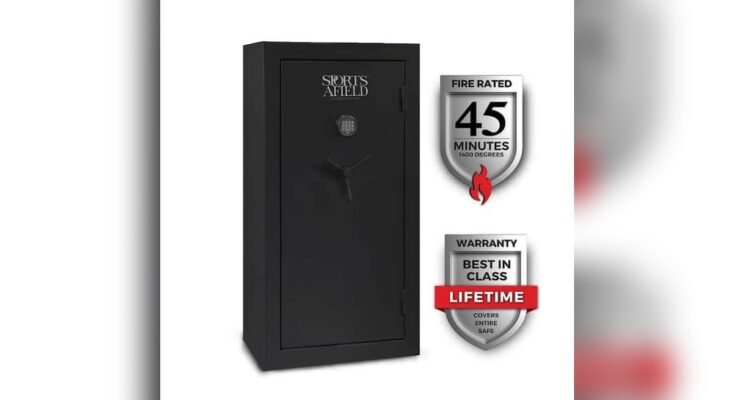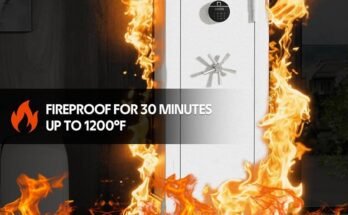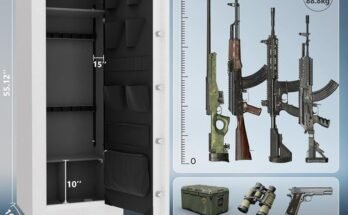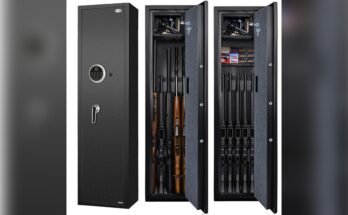Are you wondering if you can bolt down a fireproof rifle safe to keep your firearms extra secure? You want to protect your rifles not just from fire, but also from theft or accidental tipping.
Knowing whether bolting your safe to the floor or wall is possible—and how to do it right—can make all the difference in keeping your valuable firearms safe. You’ll discover the key facts, simple steps, and important tips that will give you peace of mind and make your safe truly secure.
Keep reading to find out how to take your gun safety to the next level.
Benefits Of Bolting Down A Rifle Safe
Bolting down a fireproof rifle safe adds important benefits. It protects your firearms better and keeps the safe stable. This simple step makes a big difference in safety and security. Below are key benefits of securing your rifle safe firmly to the floor or wall.
Enhanced Security
Bolting down a rifle safe stops it from being moved easily. Thieves cannot carry the safe away quickly. It makes breaking into the safe much harder. This extra security layer protects your guns and valuables.
Prevention Of Theft
Thieves prefer quick and easy targets. A bolted-down safe cannot be taken on the spot. This reduces the chance of theft significantly. It forces thieves to find other, less secure options.
Stability During Emergencies
During fires or earthquakes, a bolted safe stays in place. It prevents the safe from tipping over or sliding. Your firearms stay protected, even in emergencies. This stability adds peace of mind.
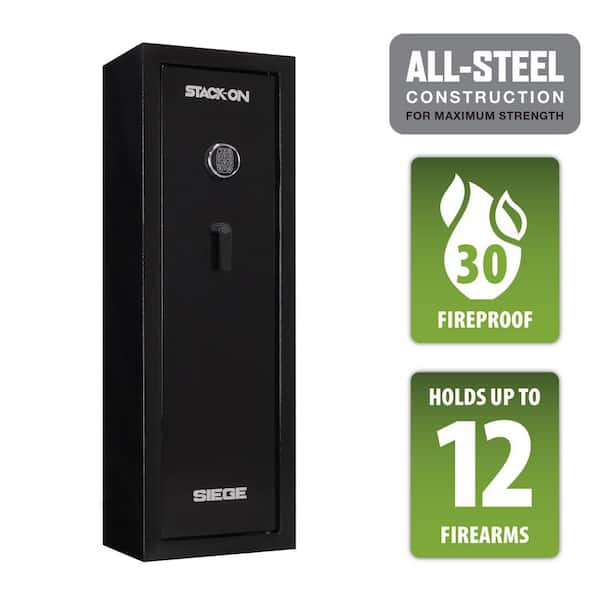
Types Of Fireproof Rifle Safes
Fireproof rifle safes come in different types to fit various needs and spaces. Each type has its own benefits and uses. Knowing these types helps choose the right safe for your rifles.
Some safes are easy to move. Others stay fixed in one place. Some fit inside walls, saving floor space. Understanding the differences is key to securing your firearms well.
Portable Safes
Portable fireproof rifle safes are small and light. They allow easy transport and quick access. These safes protect rifles from fire and theft during travel. Their size limits how many rifles you can store.
Built-in Wall Safes
Built-in wall safes fit inside a wall cavity. They save floor space and keep rifles hidden. These safes offer strong fire protection and security. Installation requires cutting into the wall and proper mounting.
Freestanding Safes
Freestanding safes stand on the floor and are heavy. They provide large storage space for multiple rifles. These safes offer excellent fire resistance and security. Bolting them down adds extra protection against theft.
Materials And Tools Needed
Bolting down a fireproof rifle safe requires the right materials and tools. This ensures the safe stays secure and stable. Using proper equipment makes the job easier and safer. Here is a list of what you need to get started.
Anchors And Bolts
Choose strong anchors made for concrete or wood floors. Use bolts that fit the safe’s mounting holes. Steel bolts are best for strength and durability. Make sure bolts are long enough to go deep into the floor.
Drilling Equipment
A power drill with suitable drill bits is necessary. Use masonry bits for concrete or stone floors. Wood bits work well on wooden floors. A hammer drill can speed up drilling into hard surfaces.
Safety Gear
Wear safety glasses to protect your eyes from dust and debris. Use ear protection to reduce noise from drilling. Gloves help protect your hands from sharp edges and tools. Always follow safety rules to avoid injury.
Step-by-step Bolting Process
Bolting down a fireproof rifle safe adds security and prevents theft. The process is simple but requires care and the right tools. Follow these steps to secure your safe properly.
Choosing The Right Location
Select a solid surface like concrete or wood flooring. Avoid placing the safe on weak or hollow floors. Choose a spot hidden from plain view. Ensure the area has enough space around the safe for easy access.
Marking Bolt Positions
Place the safe in the chosen spot. Open the safe door fully. Use a pencil to mark the holes at the base of the safe. These marks will guide your drilling. Double-check the marks for accuracy before drilling.
Drilling Into The Floor
Use a drill with a masonry bit for concrete floors. For wooden floors, a regular drill bit works fine. Drill holes at the marked spots carefully. Keep the drill straight to avoid angled holes. Clean debris from the holes before bolting.
Securing The Safe
Insert heavy-duty anchor bolts into the drilled holes. Align the safe’s holes with the bolts. Tighten the bolts firmly using a wrench. Check that the safe does not move or wobble. Your rifle safe is now securely bolted down.
Common Mistakes To Avoid
Bolting down a fireproof rifle safe adds security and peace of mind. Many make simple mistakes that reduce safety or damage the safe. Avoid these common errors to keep your safe secure and intact.
Pay attention to details and follow the right steps. This helps protect your firearms and valuables better.
Incorrect Bolt Size
Using the wrong bolt size weakens the hold of your safe. Too small bolts can break or pull out easily. Too large bolts might damage the safe or floor. Use bolts recommended for your safe model. Check bolt length and thickness before installation.
Ignoring Floor Material
Different floors need different bolts and anchors. Concrete floors require heavy-duty anchors. Wooden floors need bolts suited for wood. Installing the wrong type can cause loose fixing. Inspect your floor and choose bolts that match its material.
Overlooking Manufacturer Guidelines
Manufacturers provide instructions for safe installation. Ignoring these can void warranties or cause damage. Follow their bolt size and placement advice carefully. Use the tools and parts they suggest. Reading the manual helps avoid costly mistakes.

Alternative Security Options
Bolting down a fireproof rifle safe is not the only way to secure your firearms. There are other options that can add layers of protection. These methods can work well alone or together for better security. Explore these alternatives to keep your safe and weapons secure.
Using Security Cables
Security cables are strong steel wires that lock your safe to a fixed object. They are flexible and easy to use. You loop the cable through safe handles and anchor it to a heavy or immovable item. This makes it hard for thieves to carry the safe away. Cables offer a good option when bolting is not possible.
Alarm Systems
Alarm systems alert you if someone tries to move or open your safe. Many safes come with built-in alarms or can connect to home security systems. Loud alarms scare off intruders and notify neighbors. Some alarms send alerts to your phone. This instant warning helps protect your firearms quickly.
Camouflage And Concealment
Hiding your safe in plain sight can add security. Camouflage means placing the safe in a spot that blends with surroundings. You can use furniture, closets, or hidden compartments. Concealment reduces the chance of the safe being found by burglars. It works well with other security methods for extra protection.
Maintaining Your Bolted Safe
Maintaining your bolted fireproof rifle safe is essential for long-term security. A well-kept safe stays strong and protects your valuables. Proper care helps avoid damage and keeps the locking system working smoothly.
Regular attention ensures your safe performs at its best. Small checks and simple cleaning go a long way. Upgrading security features can also improve protection over time.
Regular Inspections
Check your safe’s bolts and anchoring points often. Look for any signs of rust or looseness. Tighten bolts if you find any movement. Inspect the fireproof seals for cracks or wear. Catching problems early prevents bigger issues later.
Cleaning And Care
Wipe the safe’s exterior with a soft cloth. Avoid harsh chemicals that can damage the finish. Clean the locking mechanism gently using a dry brush or compressed air. Keep dust and dirt away to maintain smooth operation. Make sure no moisture builds up inside the safe.
Upgrading Security Features
Consider adding extra locks or alarms for better protection. Replace old or worn-out locking parts as needed. Look into newer fireproof seals or insulation materials. These upgrades keep your safe secure against new threats. Stay aware of available security improvements for your model.

Frequently Asked Questions
Can I Bolt Down A Fireproof Rifle Safe Securely?
Yes, you can bolt down a fireproof rifle safe. It enhances security by preventing theft and movement. Use appropriate anchors and bolts designed for your floor type. Always follow the manufacturer’s instructions for proper installation and safety.
What Tools Do I Need To Bolt Down A Rifle Safe?
You need a drill, masonry bits, heavy-duty bolts, and anchors. A wrench or socket set helps tighten bolts securely. Choose tools based on your floor material, like concrete or wood, for effective installation.
Will Bolting Affect The Fireproof Rating Of The Safe?
No, bolting does not affect the fireproof rating. The safe’s fire resistance depends on its materials and design. Bolting only secures the safe, offering extra protection against theft, not influencing fireproof capabilities.
Can I Bolt A Rifle Safe On Carpeted Floors?
Bolting on carpeted floors is possible but less secure. You must bolt through the carpet into the solid floor beneath. Ensure the floor is strong enough to hold the bolts tightly for maximum security.
Conclusion
Bolting down a fireproof rifle safe adds extra security. It helps prevent theft and keeps the safe stable. Make sure to use the right bolts and tools. Check the floor type before drilling holes. Proper installation protects your valuables better.
Always follow the manufacturer’s instructions carefully. A secured safe gives peace of mind. Choose the best spot for easy access and safety. Safe and simple steps can improve your protection. Your firearms stay safer with a bolted-down safe.
